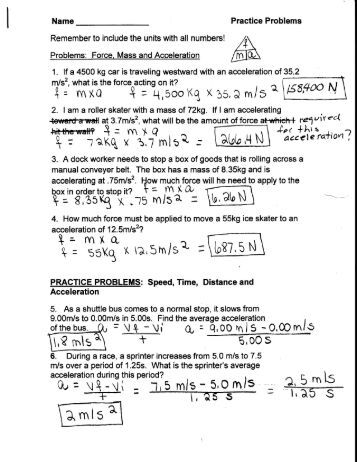Study Guide Velocity And Acceleration Answers
& Kinematics is the description of motion. The motion of a point particle is fully described using three terms - position, velocity, and acceleration. For real objects (which are not mathematical points), translational kinematics describes the motion of an object's center of mass through space, while angular kinematics describes how an object rotates about its centre of mass. In this section, we focus only on translational kinematics.
The Basic Life Support for Healthcare Providers Handbook is part of the American. The care steps outlined within this handbook are consistent with the 2010. No information is available for this page.Learn why. 2016 bls manual. Feb 16, 2016 - AHA, The BLS Provider Manual contains all of the information students need to know to successfully complete the BLS Course. Feb 1, 2016 - The Paperback of the Basic Life Support (BLS) Provider Manual by American Heart Association at Barnes & Noble. FREE Shipping on $25.0. Basic Life Support (BLS) Provider Manual #15-1010 Contains all of the. Publisher: Channing L Bete Co Inc; 1 edition (February 1, 2016); Language: English.
Velocity And Acceleration Formulas
Position, displacement, velocity, and acceleration are defined as follows. Contents. Position 'Position' is a relative term that describes the location of an object RELATIVE to some chosen stationary point that is usually described as the 'origin'.

A vector is a quantity that has both magnitude and direction, typically written as a column of scalars. That is, a number that has a direction assigned to it. In physics, a vector often describes the motion of an object.
For example, Warty the Woodchuck goes 10 meters towards a hole in the ground. We can divide vectors into parts called 'components', of which the vector is a sum. For example, a two-dimensional vector is divided into x and y components.
A Daniel Sims study guide turing motion 1.1 Motion diagrams 1.1.1 a motion diagram is a powerful tool for studying motion 1.1.1.1 it is consecutive frames were the background is the same 1.1.2 when the motionless objects in the background do not change position the object is at rest. 1.1.2.1 If the change in position between each frame gets bigger the object is moving faster if it's getting shorter it's slowing down. 1.1.2.2 If the distance between each image in each frame is the same the the object is moving at a constant speed. 1.1.3 The 4 concepts of the study of motion 1.1.3.1 at rest 1.1.3.2 speeding up 1.1.3.3 slowing down 1.1.3.4 constant speed 1.1.3.4.1 each of these are called operational definition 1.2 The particle model 1.2.1 keeping track o f an object is easier if one d isregarded things like spinning wheel, arms, legs, and bobble head dolls, on concentrated on a single point on the object. 1.2.1.1 This type of model is called a particle model 1.2.2 /////CRITICLE-W ARNING in order to use the particle one MUST make sure the size of the object is less then the distance it moves here and when? 2.1 Coordinate system 2.2 Placing a clock and a meter stick in the path of a camera helps one deter man the distance and travel at each time interval.
2.2.1 By doing this the experiment crew defines the coordinate system. 2.2.1.1 This tell you the zero point of the variable you are stud ying and the direction those variables increase. 2.2.1.1.1 The point at which the variables have the value zero is called the origin 2.2.2 in a mot ion diagram the origin would be zero on the me asuring device. 2.2.3 The measuring device should be in a straight line 2.2.3.1 how ever it doe s not matter if the tape if going left or right relative to the camera. 2.2.4 A position vector is used to find the distance traveled relative to the origin.
2.2.4.1 The arrow would go to the dot on a particle model. 2.2.4.2 The length of the arrow is perpotional to the distance of the object from the origin and the points from the location of the object at a particular time. 2.2.4.3 Negative positions are possible 2.3 Vectors and scalars 2.3.1 a quantity that tells you the magnitude of something is called a scalar qu antity. 2.3.2 The distance between two cities is a scalar quantity 2.3.2.1 When represented by an arrow it is a vector quantity 2.3.2.2 Scalar quantities are represented by letter while vectors ha ve a letter and a line over it.
2.4 Time intervals and displacement.